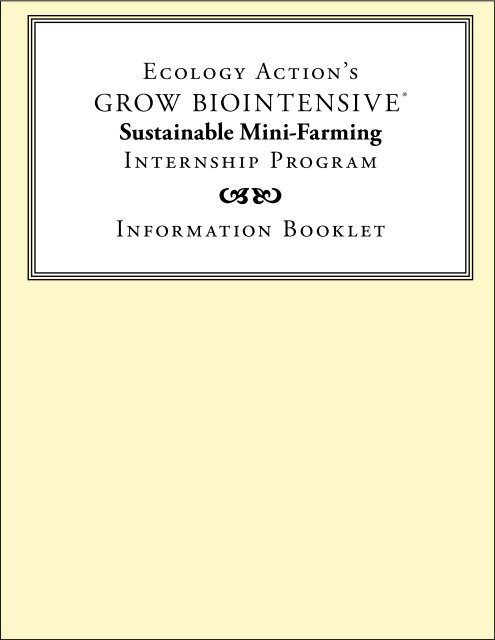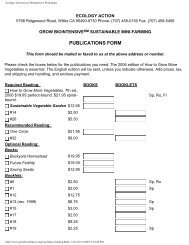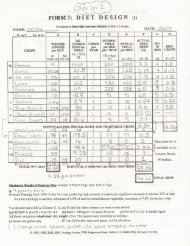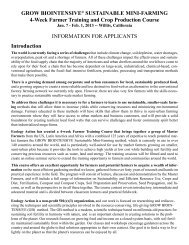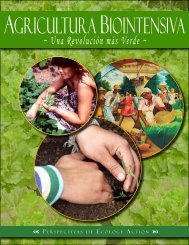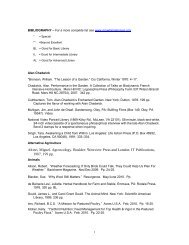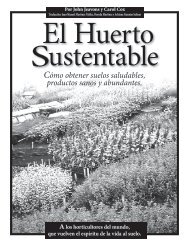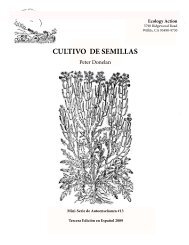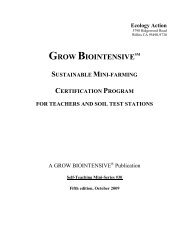Internship Information Booklet - Ecology Action
Internship Information Booklet - Ecology Action
Internship Information Booklet - Ecology Action
You also want an ePaper? Increase the reach of your titles
YUMPU automatically turns print PDFs into web optimized ePapers that Google loves.
<strong>Ecology</strong> <strong>Action</strong>’sGROW BIOINTENSIVE ®Sustainable Mini-Farming<strong>Internship</strong> Program<strong>Information</strong> <strong>Booklet</strong>
<strong>Ecology</strong> <strong>Action</strong>’sGROWBIOINTENSIVE ®Sustainable Mini-Farming<strong>Internship</strong> Program<strong>Information</strong> <strong>Booklet</strong>© 2010 <strong>Ecology</strong> <strong>Action</strong>5798 Ridgewood Road, Willits, CA 95490-9730 USA
THE SITESThe Common Ground Mini-Farm, Willits, CAThis is the location of <strong>Ecology</strong> <strong>Action</strong>’s Headquarters, and is our most established research garden, started in1985. 1.25-acre garden where interns work and learn is located in a rural mountain environment outside thesmall town of Willits, CA. The garden consists of approximately 110 GROW BIOINTENSIVE garden beds andis watered from a gravity-fed spring. Interns are housed in a yurt and rustic cabins, with shared bedrooms and acommon area, including a kitchen where communal meals are prepared and eaten. Most of the site is "off-grid",fueled by solar power; however, some buildings do not have electrical power. A composting privy and a solarshower comprise the bathroom facilities. This site would be challenging for an intern who does not like to liveclose to the earth, but the work is interesting and rewarding, and the surroundings are beautiful. A small staff andJohn Jeavons' family live on site year-round; interns arrive from around the world periodically.The Research Garden at the Golden Rule Ranch, Willits, CAThe Golden Rule Ranch, once home to the racehorse Seabiscuit, is now owned by Christ’s Church of the GoldenRule, and has been home to <strong>Ecology</strong> <strong>Action</strong>’s second research garden for the past 10 years. Also located outsideof Willits, near the <strong>Ecology</strong> <strong>Action</strong> Headquarters site, the Golden Rule site is located in a valley, which providesless challenging growing conditions than the Mini-Farm, allowing interns the important experience of growingin different climates and conditions. The research garden consists of approximately140 GROW BIOINTENSIVEbeds, and a large greenhouse. Interns live on-site in shared housing, which, while rustic, is more developed thanthat at the Headquarters site. Electrical power is “on the grid”, and bathroom facilities are indoors.The Research Garden at Stanford Inn by the Sea, Mendocino, CAOur newest research garden is at Stanford Inn by the Sea. Stanford is an Eco-Inn located on a coastal hillsidemeadow overlooking Mendocino Bay near the small town of Mendocino. The Inn has converted its entire tenacres to sustainable and organic gardening and landscaping. In a partnership with <strong>Ecology</strong> <strong>Action</strong>, Stanford Innhas provided the facilities for the research garden, currently consisting of about 40 beds which interns establishedin the 2010 internship program. This site provides the experience of working and learning to grow sustainablyin a coastal setting. Interns are housed a small quarters and trailer on-site, provided by the Inn. The facilities aremodest, but are more modern than the Headquarters site, with electrical power and indoor bathrooms.2 <strong>Ecology</strong> <strong>Action</strong>’s GROW BIOINTENSIVE <strong>Internship</strong> <strong>Information</strong> <strong>Booklet</strong>
THE PROGRAM6- and 12-month internships are available in GROW BIOINTENSIVE sustainable mini-farming research andthe low-technology lifestyle appropriate to development work. <strong>Internship</strong>s begin in mid-April of each year. Anextended 3 year apprenticeship is also available. For more information, please see the Apprenticeship materialsonline at www.growbiointensive.org.<strong>Ecology</strong> <strong>Action</strong>’s garden sites, while beautiful and enjoyable to work in, are first and foremost research gardenswhere a multitude of experiments are run concurrently. The research focus is on using the GROW BIOINTEN-SIVE method to conduct scientific tests and collect data to provide solutions to the challenge of creating andmaintaining sustainable soil fertility on a closed-system basis, while living a sustainable life. Interns have an opportunityto learn valuable techniques and information, to experience an alternative living style, to make lifelongties with other interns from different states and countries, and to assist <strong>Ecology</strong> <strong>Action</strong> in accomplishing workthat can help farmers, gardeners, and communities around the world to raise food, conserve resources and buildfertile soil, sustainably.The GROW BIOINTENSIVE® method focuses on using small-scale, organic, non-mechanized food-raisingtechniques as a way of life. The work we do requires commitment, responsibility, patience, attention to detail,willingness to follow detailed instructions, self-motivation, and mental and physical stamina. While we do notwish to discourage those genuinely interested in the program, we also want to make sure that applicants have anadventurous, hardy nature and can make a dedicated commitment to the program and its unusual living conditionsfor the duration of the internship.Originally limited to a 3-year apprenticeship, our teaching course has expanded to accommodate increased interestin the program to include 6 in the summer and 12-month internships. These internships are intended for peoplewho already have an established understanding of the GROW BIOINTENSIVE method, and want to take theirskills to the next level.Specifically, we have developed these internships for people who:• Have already taken a workshop or other course in the GROW BIOINTENSIVE method, or are involved inestablished projects and programs that use the method;• Are interested in an in-depth understanding and experience of why GROW BIOINTENSIVE works and howto modify it for other climates, soils and cultures; and• Expect to be actively involved in public service in this kind of work (with selective preference given to thosewho have a strong interest in applied sustainable farming and/or demonstrate a significant ability to use theskills they gain through an internship to benefit their communities and the planet).The internship is a combination of:• Lecture and demonstrations,• Study,• Garden work, and• Living the method.<strong>Ecology</strong> <strong>Action</strong>’s GROW BIOINTENSIVE <strong>Internship</strong> <strong>Information</strong> <strong>Booklet</strong>3
This combination is designed is so that participants learn <strong>Ecology</strong> <strong>Action</strong>’s processes both theoretically and practically,and can understand the processes that are involved in starting this type of work (GROW BIOINTENSIVEfarming, low-tech living, teaching the method to others) as well as doing it over the long-term. The internshipsare an opportunity to assist <strong>Ecology</strong> <strong>Action</strong> in accomplishing its work, with both direct and indirect learning occurringin the process.During the internship, emphasis is placed on the ability of the intern to learn to farm and develop GROW BIO-INTENSIVE designs and approaches, in the belief that the most creativity and strength come from people joiningforces and working as a team after they have fully developed strength and independence. We have found that skilllevels can be dramatically upgraded with this type of training.Interns are generally free of administrative responsibilities during the program, and are able to focus on learningthrough reading, classes, and work in the research garden. Time is available for an independent study project, andthere are periodic meetings with an <strong>Ecology</strong> <strong>Action</strong> staff member. There are also weekly meetings with staff andother interns to discuss progress in the research mini-farm garden. The Interns will take part in seasonal coursesand workshops. Depending on the work done and the level of involvement demonstrated by the intern, it is possiblethat the internship can lead to an <strong>Ecology</strong> <strong>Action</strong> certification as a GROW BIOINTENSIVE teacher.THE LEARNING PROCESSWe have found that, after an initial acclimatization period for interns at <strong>Ecology</strong> <strong>Action</strong>, usually a few weeks duringwhich we get to really know you, it is easier to see how the new skills and information being taught can bestbe integrated with your life and work, and we can better help you plan for the future. As you progress throughyour internship, you will continue to realize the interconnections in the topics you are studying, and the real decisionsabout how to apply what you have been learning to your future can be made. The internship will build thestudy and work skills that will help you more easily identify and learn the things you still need to know. It willalso give you a chance to study and research more fully the topics that are most important to you, and to formulateand answer your own questions.As an intern, you can learn as much as you want to learn. Within the context of the program and your duties as aresearch assistant, what you do with your time at <strong>Ecology</strong> <strong>Action</strong> is really up to you, because we value independenceand believe it is important to foster the creativity that is so important to successfully developing and teachingsolutions to global farming challenges.In addition to the structured learning that takes place through lectures and reading, interns will find that learningalso takes place on a more subconscious level as you get a feel for the rhythms of the method. Through repetitionof on-going farm duties and seeing the fundamental need for a garden’s balance between carbon and calories asexhibited by what is being planted and harvested, a profound, almost involuntary learning occurs in interns thatis often not realized until time has passed or until participants return to their communities and begin to teach others.4 <strong>Ecology</strong> <strong>Action</strong>’s GROW BIOINTENSIVE <strong>Internship</strong> <strong>Information</strong> <strong>Booklet</strong>
CANDIDATES<strong>Ecology</strong> <strong>Action</strong> admits workshop participants, interns and volunteers by selecting the most qualified candidatesfrom around the world, and we give priority in the selection process to candidates from the most qualified projectsand national programs that need strengthening. Particular priority will be given to those programs already emphasizingOne-Bed Unit models, calorie/carbon crop growing, and complete multi-bed-unit systems, and to thoseindividuals committed to making GROW BIOINTENSIVE Mini-Farming their life-time work. The programrequires that interns be willing to devote at least two years following the internship to a GROW BIOINTENSIVEfollow-up project or program.The candidates that best fit the program will share <strong>Ecology</strong> <strong>Action</strong>’s commitment to the GROW BIOINTENSIVEmethod of food-raising and to a simple life-style. They should be familiar with and have worked with <strong>Ecology</strong><strong>Action</strong> publications, and they should be prepared to devote their attention to working within the parameters of theGROW BIOINTENSIVE method for the duration of the internship. Although we appreciate that people who areinterested in sustainable agriculture may be interested in exploring other methods and tools, please note that thisinternship is focused exclusively on the GROW BIOINTENSIVE method, and that exploration of other methodsand philosophies such as permaculture, rock dust/ remineralization, raw foods, etc., will not be possible duringyour internship with us.The best candidate for this program will be experienced in GROW BIOINTENSIVE mini-farming. Their principallearning goals will be:• To experience the particular temperate climate and soil of the research garden sites.• To gain a deeper understanding of the GROW BIOINTENSIVE method and soil building principles and howthey relate synergistically.• To develop an understanding of how the GROW BIOINTENSIVE research, training and demonstration sitesare run as a possible model for their own mini-farm and/or teaching program.<strong>Internship</strong> candidates seeking answers to specific long-term goals related to a GROW BIOINTENSIVE projector program will be given preference in the admission process, because having a focus of this sort maximizes thebenefit the intern receives through the program. Willingness to take appropriate initiative, assume responsibilityand provide follow-through is a key characteristic for interns.After completing this program, interns are expected to engage in GROW BIOINTENSIVE farming, teach GROWBIOINTENSIVE classes and send annual reports of their activities to <strong>Ecology</strong> <strong>Action</strong> for two years followingtheir internship.<strong>Ecology</strong> <strong>Action</strong>’s GROW BIOINTENSIVE <strong>Internship</strong> <strong>Information</strong> <strong>Booklet</strong>5
SCHEDULE, ACCOMMODATIONS, FOODSimple accommodations are provided, as described above, with other needs provided for by the intern (see “SuggestedItems …” on p.8). Our commitment to simple living includes simple eating. Food is purchased through an<strong>Ecology</strong> <strong>Action</strong> coordinator who integrates intern food requests as best as possible. Interns prepare the meals ona rotation basis; meals range from vegetarian to vegan. Not all of our food is grown in the garden; some food ispurchased at the Farmers’ Market and elsewhere. Normally, we are not able to accommodate fruitarian or otherspecialized diets. Cooking, dish-washing and other household responsibilities among the interns are shared.All interns and members of the regular garden/mini-farm staff work Monday through Thursday. Work times varybut are generally from 9:00 a.m. to approximately 8:30+ p.m., with time off for lunch and dinner. The “week-end”consists of approximately 1-1/2 days off during the next three days (for example, Friday and 1/2 of Sunday; 1/2of Friday and all of Saturday; and so on, with the pattern of days-off changing from week to week to ensure thatall interns have equal opportunity for rest and socialization). When there are sufficient people in the program,there are two-day weekends off every other week. In addition two, 3-day weekends are scheduled for each intern:one before July and after August. <strong>Ecology</strong> <strong>Action</strong>’s staff is small and extremely busy, so weekend activities aredetermined by each intern. The internship program is intensive, and other than the designated days off and prearrangedvacation, time is not available for extracurricular sight-seeing, travel or farm visits.SAMPLE DAILY SCHEDULE(The schedule may be adjusted depending on the weather/season.)8:00 - 9:00 Breakfast9:00 - 12:30 Garden Work / Class / Reading12:30 - 2:30 Spot Watering / Lunch (one hour)2:30 - 5:30 Garden Work / Class / Reading / Cooking5:30 - 6:30 Evening Watering / Break *6:30 - 7:30 Dinner *7:30 - 9:00 Dishes and Kitchen Clean-up / Evening Watering */Studies and relaxationVACATIONSIn addition to the scheduled “week-ends”, each intern receives 7 vacation days in August, at a time that does notinterfere with scheduled classes or garden activities. If you are interested in travelling while you are in the US,you should make sure that you schedule any longer trips to occur either before you begin the internship or afteryou finish it.6 <strong>Ecology</strong> <strong>Action</strong>’s GROW BIOINTENSIVE <strong>Internship</strong> <strong>Information</strong> <strong>Booklet</strong>
CURRICULUMThe Intern’s Summer Course is currently taught all day Monday for approximately the first three and ½ monthsof the internship. All interns participate in this course and the major classes include:Introduction of <strong>Ecology</strong> <strong>Action</strong> Goals; World Situation; “Tour”, Course/<strong>Internship</strong> Overview: Classes,Garden Work, Responsibilities, Expectations: Mini-Farm Design Project; Independent Study Project, etc.Presentation of 21-Bed, 3-Bed and 1-Bed Units; Bed-Crop-Months; 72-Bed UnitAdvantages of GROW BIOINTENSIVE Bed PreparationCompostCompost CropsDietIncomeSustainabilityFertilizers / FertilitySeed PropagationGarden PlanningCompanion PlantingSeed Collection/SavingWater Use/Arid Farming TechniquesHuman Waste RecyclingPractical Watering PrinciplesInsects and DiseasesPhilosophy/HistoryCrafts: Lavender WandsDepending on circumstances, Herbal Salves/Tinctures and/or Solar Oven Construction may be included.On even numbered years, GROW BIOINTENSIVE Teachers Workshops leading to certification are held in July.Presentations of the diet/compost/income mini-farms designed by each intern during the summer course willbe presented in early September. In addition to the classes and project work during the Summer Course and theTeachers Workshop, interns have the option of revising their Mini-Farm Design Project, doing an all-nutrientevaluation of their diet design, or an Independent Study Project (with presentations in early October). For amore detailed description of the daily activities for an internship, see the Sample Schedule/Curriculum/ReadingList on page 15 of this booklet.INTERNSHIP EXPENSESSince <strong>Ecology</strong> <strong>Action</strong> is a small, non-profit organization, financial aid is limited, and this is a fee-based internship,with cost estimates indicated in the tables on the next page.Special scholarships or stipends may be available depending on the situation of the applicant (demonstratedmerit and financial need) and the program they are associated with (ability of the applicant to use the skills theygain through the program to benefit their community and the planet). Funding may be provided by the programsponsoring the participant, by the participant him/herself, and/or corporations, foundations, and/or individuals.Please be sure to explore funding through all avenues available to you.<strong>Ecology</strong> <strong>Action</strong>’s GROW BIOINTENSIVE <strong>Internship</strong> <strong>Information</strong> <strong>Booklet</strong>7
Cost Estimate for a Six-Month <strong>Internship</strong> at <strong>Ecology</strong> <strong>Action</strong>, 2015Direct Costs Interns from the U.S.A. Interns from Other CountriesTuition $3,000* $3,000*Room 1,200* 1,200*Food 900 900Utilities 300 300Publications 320 320Supplies 300 300Phone/Internet 240 240Incidentals 1,200 1,200Medical Insurance 600 600Administration 1,500* 1,500*Co-Sponsoring + visa — 3,100SEVIS Form — 180Transportation 250-500 600–2,500TOTAL $9,810-10,060 $13,540-15,440TOTALS if scholarship available $4,110-4,360 $7,840-9,740*One or more costs sometimes waived, when scholarship is available.Cost Estimate for a 12-Month <strong>Internship</strong> at <strong>Ecology</strong> <strong>Action</strong>, 2015Direct Costs Interns from the U.S.A. Interns from Other CountriesTuition $6,000* $6,000*Room 2,400* 2,400*Food 1,800 1,800Utilities 600 600Publications 282 282Supplies 600 600Phone/Internet 480 480Incidentals 2400 2400Medical Insurance 1,200 1,200Administration 3,000* 3,000*Co-Sponsoring + visa — 3,100Interview Fee — 100SEVIS Form — 180Transportation 500-1,000 1,200–5,000TOTAL $19,300-19,800 $23,380-27,180TOTALS if scholarship available $7,900-8,400 $11,980-15,780*One or more costs sometimes waived, when scholarship is available.8 <strong>Ecology</strong> <strong>Action</strong>’s GROW BIOINTENSIVE <strong>Internship</strong> <strong>Information</strong> <strong>Booklet</strong>
Notepads, pencils, etc.SUGGESTED ITEMS FOR INTERNS TO BRINGBe prepared for rustic conditions with limited water and electricityClothes for hot or cold days, cool or cold evenings, rain, snow, etc., including rain gear. (Day-time temperaturesat all sites can vary from 55°F to 105°F [12.7°C to 40.5°C] in one day, and night-time temperatures can be aslow as 25°F [-4°C]). Old work clothes are best. Bring plenty — self-service laundry facilities are 30 minutesaway by car, in town.Shoes/workboots should have good tread. In addition to garden work, paths are steep, so make sure your feetare prepared! A good pair of waterproof boots with heavy treaded soles is also useful.A good sun hat is a must. Remember to bring sun screen/lotion and a swimsuit, if desired. We try to allowtime for a swim in a nearby pond, work and weather permitting.Towel, washcloth, etc. — Solar showers will available at least every other day. Shavers and appliances need tobe non-electric or battery-powered.Lighting — Flashlights and possibly a battery-powered lantern, for reading at night. Bring plenty of operatingrechargeable batteries.Bedding:International interns: bedding will be provided.Optional for U.S. participants only: sheets for full-size bed, pillow, pad, and other warm,durable sleeping items. If you do not bring your own bedding, it will be provided for you.Other items:• Favorite vegetarian/vegan recipes• Battery-operated radio and/or CD player and two sets of rechargeable batteries• Musical instruments, art supplies, etc. are welcomed.Parking space is very limited — small cars for US participants and/or car pooling is encouraged.<strong>Ecology</strong> <strong>Action</strong>’s GROW BIOINTENSIVE <strong>Internship</strong> <strong>Information</strong> <strong>Booklet</strong>9
ARRIVAL AND DEPARTUREIf you are not a US citizen and are travelling to the United States from another country, you should arrange foryour visa to expire on the last day of your stay at <strong>Ecology</strong> <strong>Action</strong>. It is our understanding that you have 30 daysafter your visa expires to leave the U.S. *NOTE: <strong>Ecology</strong> <strong>Action</strong> interns travelling on visas do not have theoption of employment while participating in the program and are required by law to return home when their visaexpires.It is important to schedule your arrival at the research garden site in the early evening of the Sunday before youofficially begin your internship, so that there will be time to settle in before things begin early Monday morning.For example, the 2015 internship officially starts Monday, the 13th of April; interns will be arriving on Sunday,the 12th of April.If you are flying in and need us to arrange for transportation from the San Francisco Airport to the research site,you need to schedule your arrival for Sunday morning in order for us to get you to your site by early evening.You should schedule your departure flight to leave the San Francisco Airport during the late afternoon orevening on the day listed below, as we will be leaving your research sites in the morning, and must allow timeto reach the airport, which is approximately 3.5 hours away, and to leave time for airport processing (airportsrecommend arriving at least 2 hours before your flight is scheduled to depart).• 6-month interns for 2015: depart Saturday October 10th 2015• 12-month interns for 2015: depart Saturday April 9th 2016Please note: The cost of any excess baggage fees on the return trip is the responsibility of the intern. It is a goodidea to determine well in advance of your departure how much baggage you will be carrying.Before you leave, you are responsible for removing your possessions and cleaning your living quarters so thatthe next interns have a comfortable and welcoming experience!FOLLOW-UP ACTIVITIESIt is expected that graduates of the internship program are prepared to continue and/or initiate GROW BIOIN-TENSIVE mini-farms, classes, and other related activities for at least two years following the internship. Duringthe period of the internship, participants will be able to work with a staff member to plan their future activitiesprogram. Those interns wishing to become GROW BIOINTENSIVE certified teachers should read <strong>Ecology</strong><strong>Action</strong> <strong>Booklet</strong> #30 available online at www.growbiointensive.org.For a schedule of recommended activities upon completion of your internship, please see the Two Year PlanningTemplate for 6-month Interns on page 23 of this booklet.10 <strong>Ecology</strong> <strong>Action</strong>’s GROW BIOINTENSIVE <strong>Internship</strong> <strong>Information</strong> <strong>Booklet</strong>
POST-INTERNSHIP TECHNICAL/FINANCIAL ASSISTANCE<strong>Ecology</strong> <strong>Action</strong> and its staff love our interns and are delighted to make this learning opportunity possible. Afterall, the next generation of GROW BIOINTENSIVE interns are pioneers and are a hope for sustainable agriculturearound the globe. We often make special efforts to enable interns to come to this training and periodicallytake significant financial risks to ensure that participants are able to come to learn with us.At the same time, it is important to note that <strong>Ecology</strong> <strong>Action</strong> is a very small, low-income (by U.S. standards)organization with a small staff, and is generally not in a position to make or find financial grants and/or to provideproject/program gifts to participants or their projects (e.g. pumps, solar panels, computers, cameras, tools,etc.). Any technical funding assistance provided to a project/program by <strong>Ecology</strong> <strong>Action</strong> normally grows fromevidence of a thorough understanding, use and practice of the GROW BIOINTENSIVE® method by the staff ofthe project seeking assistance, and normally occurs only after several years of evaluation.<strong>Ecology</strong> <strong>Action</strong>’s long-term emphasis is to enable the establishment of five worldwide GROW BIOINTEN-SIVE regional centers and national mini-ag demonstration centers and to promote quality assurance for GROWBIOINTENSIVE practices. <strong>Ecology</strong> <strong>Action</strong> has no additional projects of its own other than its mail-order service,Bountiful Gardens, and its organic gardening supply store, Common Ground. When independent GROWBIOINTENSIVE efforts are found to be worthy of assistance, <strong>Ecology</strong> <strong>Action</strong> sometimes takes the initiative tohelp such efforts. <strong>Ecology</strong> <strong>Action</strong> provides technical assistance through publications, workshops, certification,and so on, but rarely through financial assistance.<strong>Ecology</strong> <strong>Action</strong>’s GROW BIOINTENSIVE <strong>Internship</strong> <strong>Information</strong> <strong>Booklet</strong>11
MEDICAL REPORT for ECOLOGY ACTION INTERNSHIP APPLICANTS(page 1 of 2)This report must be completed by a licensed doctor who has examined the applicant to the internshipprogram and knows his/her medical history.Upon completion of the form, please either FAX both pages to <strong>Ecology</strong> <strong>Action</strong> at +1-707-459-5409 orscan it and email both pages as either a PDF or JPEGs to contact@growbiointensive.org.In either case, please include “<strong>Internship</strong> Application Medical Form for {patient’s name}” as the subjectline in the fax or email, so that we know who the form belongs to._________________________________________________________________________________________Name of the Patient: _____________________________________ Height: _______Weight: _____Sex: M/ FDate of the examination:_____/_____/______ Examination location (city): ___________________________Name of Doctor: ____________________________________License number:_________________________Doctor’s Contact <strong>Information</strong>:________________________________________________________________________________________________________________________________________________________1) How long have you known the patient? ___________________2) Does the patient or any close relative have a contagious disease? Yes /NoIf you answered yes, please describe:__________________________________________________________________________________________________________________________________________________________________________________3) Does the patient have any history of serious injury, illness or disease? Yes /NoIf the answer is yes, please describe the condition, duration of the treatment, age of the patient at the time oftreatment, and final result of the treatment:___________________________________________________________________________________________________________________________________________________________________________________________________________________________________________________________________________4) Please test the patient for tuberculosis. Did this patient test □ Negative or □ Positive for TB?5) Is the patient currently taking any prescription medicine or in need of ongoing medical treatment? Yes / NoIf the answer is yes, please describe the medicine and reason for treatment:__________________________________________________________________________________________________________________________________________________________________________________6) Is the patient allergic to penicillin, other antibiotics or other medications? Yes / NoIf yes please specify:_____________________________________________________________________7) What year did the patient last receive a vaccination for Tetanus? ________If longer than 5 years ago, please administer now and provide the date of the injection: ___/____/______8) Does the patient smoke? Yes / NoIf the answer is yes, how many cigarettes per day? _______12 <strong>Ecology</strong> <strong>Action</strong>’s GROW BIOINTENSIVE <strong>Internship</strong> <strong>Information</strong> <strong>Booklet</strong>
MEDICAL REPORT for ECOLOGY ACTION INTERNSHIP APPLICANTS(page 2 of 2)9) Does the patient drink alcoholic beverages?□ Never □ Occasionally □ Frequently (more than 5 times per week)10) Check the box if the patient has problems or previous history with any of these conditions:□ heart disease□ shortness of breath□ nervous disorder□ dental problems□ back problems□ anemia□ gum disease□ joint problems□ fatigue/lack of energy□ allergies□ diabetes□ appetite loss□ asthma□ cancer□ drug addiction□ skin condition□ HIV+□ alcoholism□ organs□ sexually transmitted disease □ obesity□ underweight□ ulcer□ cough□ lack of mobility□ hearing loss□ infection□ broken/improperly healed bones □ poor eyesight□ depression□ bleeding□ Other.If you checked any of the boxes, please describe:___________________________________________________________________________________________________________________________________________________________________________________________________________________________________________________________________________11) This patient has applied to join a U.S. farm-training program. This program requires daily, physicallyrigorous activity. Is there any medical reason that might prevent the patient from performing well insuch a program? Yes / NoIf the answer is yes, please explain:___________________________________________________________________________________________________________________________________________________________________________________________________________________________________________________________________________12) Please indicate the general health of the patient: □ Excellent □ Good □ Fair □ PoorDoctor’s name: __________________________________________________________________________Signature:_____________________________________________________________ Date: ___/___/______Official Stamp:<strong>Ecology</strong> <strong>Action</strong>’s GROW BIOINTENSIVE <strong>Internship</strong> <strong>Information</strong> <strong>Booklet</strong>13
ECOLOGY ACTION5798 Ridgewood Road, Willits CA 95490-9730Phone: (707) 459-0150 Fax: (707) 459-5409RELEASE FORM(This form should be mailed or faxed to us at the above address or number.)Name: _____________________________________________________________________Address: ___________________________________________________________________City/State/Zip Code: __________________________________________________________Country: ______________________Telephone: (_____)____________________E-mail address (if available): _____________________________________________EMERGENCY CONTACT:Name: ____________________________________________________Address: __________________________________________________City/State/Zip Code: _________________________________________Country: ______________________Telephone: (_____)____________________************I have a _____ heart condition, _____ back condition, _____ other present and/or pre-existingconditions which could limit my full participation in the physical activities of this internship.Please describe in detail on the other side. Also, please list any medications you are currentlytaking.I hereby certify that I am in good physical condition and do hereby release, acquit and dischargeECOLOGY ACTION, its staff, officers and members, of any and all claims, causes of action ordamages whatsoever, in any way arising out of or in any manner connected with their program orany medical treatment rendered in event of need.Date of last medical examination: ________________________________Name: ____________________________________Date: _______________Signature: _________________________________________________________M1/<strong>Ecology</strong> <strong>Action</strong>/Appr-Intern/Release Form – 1/7/0514 <strong>Ecology</strong> <strong>Action</strong>’s GROW BIOINTENSIVE <strong>Internship</strong> <strong>Information</strong> <strong>Booklet</strong>
SAMPLE SCHEDULE/CURRICULUM/READING LISTActual content and activities may vary.You will receive an updated course syllabus for your internship if you are accepted to the program.ECOLOGY ACTIONCOMMON GROUND MINI-FARM5798 Ridgewood Road, Willits CA 95490-9730Phone: (707) 459-0150 Fax: (707) 450-5409ECOLOGY ACTION INTERNSHIPAndGOLDEN RULE COMMUNITY SPECIAL INTERNSHIPAndGREEN BELT INTERNSHIPSUMMER COURSE SCHEDULE AND READING LIST 2012A SAMPLE SCHEDULE OF TOPICSPlus a Reading Schedule for what to read in preparation for each topic.Interns are requested to bring your Workshop Manual, HTGMV and calculator to ALL classes,as well as other materials indicated.APRIL4/15 Arrival [ Dan & Margo] ?4/23 Mon. a.m. Summer Course Schedule and Reading Assignments (J,)Introductions and Personal Long-Term Goals (Everyone)MESA Sponsorship (J)Miscellaneous: passport and entrance form copies, medical insurance coverage (J)Library: alarm, books, borrowing policy (J)EA Interns only:“Settling In” in Apprentice/Intern Handbook, see also Priorities and ExpectationsGarden Procedures — Tool Shed; Tools; Data; Fertilizers; Garden Layout; Job List Garden ManualCourse/<strong>Internship</strong> Overview: Learning - 3 types: Beginning, Intermediate, Advanced (“Essential Points” inWorkshop Manual); 3 ways: Reading, Classes, Garden Work. Responsibilities: Garden, Site; Expectations: Mini-Farm Design Project, Independent Study Project, etc. (J,)What is <strong>Ecology</strong> <strong>Action</strong>’s purpose?Double-Digging and Watering Demonstrations—EA/GBLT and GR separatelyMinister of Life Enhancement4/24 Tues Data Class- All day4/30 Mon. a.m. Bed Preparation (J)p.m. Fertilization and Transplanting Demonstrations Compost,—EA/GBLT and GR separatelyDouble Digging / GB<strong>Ecology</strong> <strong>Action</strong>’s GROW BIOINTENSIVE <strong>Internship</strong> <strong>Information</strong> <strong>Booklet</strong>GM:EA/Appren-Intern-Vol/Interns/2012 SummerCourse Schd&RL 2/23/12— p. 115
SAMPLE SCHEDULE/CURRICULUM/READING LISTActual content and activities may vary.You will receive an updated course syllabus for your internship if you are accepted to the program.MayParticipants work on Mini-Farm Design Projects, as assigned.5/7 Mon. a.m. Seed Propagation Demonstration—EA and GBLT separately (MH)5/8 Tues. a.m. Seed Propagation Demonstration GR5/9 Wed. EA Interns only: Fire Drill (MH)5/14 Mon. a.m. Presentation of 21-Bed, 3-Bed and 1-Bed Units; Bed-Crops-Months; 72-Bed Unit (J)Materials needed: <strong>Booklet</strong>s #14, #15, #25, #26, #28,#34p.m.Introduction of <strong>Ecology</strong> <strong>Action</strong> Goals; World Situation; “Tour” (J)Video: “Circle of Plenty”; “Journey in Kenya”5/19 Sat. EA Garden Tour for the public5/21 Mon. a.m. Introduction of Mini-Farm Design Project (J)Materials needed: HTGMV Master Charts, One Circle, <strong>Booklet</strong>s #14, #15, #25, #28, #31; PreliminaryWorksheets (to be handed out in class); pencil• Assign “Solving the Diet” (Form 2) and Forms 3 and 5. Due date: 5/29p.m.Diet (J) Materials needed: One Circle• Assign Quick Diet Design Exercise. Due Date: 6/45/29 Tues. a.m. Compost (J) Materials needed: <strong>Booklet</strong> #32• Collect Forms 2, 3, 5.p.mSeed Propagation (J)JUNE6/2 Sat EA Garden Tour for the public6/4 Mon a.m. One-Bed Unit Exercise. Introduce Form 6. (J)• Collect Quick Diet Design Exercise.• Assign Form 6 to work on. Due date: 6/116/11 Mon. a.m Compost Crops (J) Materials needed: <strong>Booklet</strong>s #14, #15, #25, #32Practical Watering Principles (J)• Collect Form 6.• Organize days to eat diets.Participants work on Mini-Farm Design ProjectsPreliminary Mini-Farm Design Project Presentations (and report on one day’s diet as eaten) to be scheduled6/24 Sunday EA Garden Tour for the public6/18 Mon. a.m Income (J) Materials needed: Backyard Homestead• Assign Form 4 to work on. Due date: 6/256/25 Mon. a.m Sustainability and Preview of Human Waste Recycling (J)p.mAdvantages of Biointensive (J)• Collect Form 7.16 <strong>Ecology</strong> <strong>Action</strong>’s GROW BIOINTENSIVE <strong>Internship</strong> <strong>Information</strong> <strong>Booklet</strong>GM:EA/Appren-Intern-Vol/Interns/2012 SummerCourse Schd&RL 2/23/12— p. 2
SAMPLE SCHEDULE/CURRICULUM/READING LISTActual content and activities may vary.You will receive an updated course syllabus for your internship if you are accepted to the program.JULY7/2 Mon. a.m Planning (J) Materials needed: pencil• Collect Form 4. Assign Form 7 to work on. Due date: 7/2p.mPhilosophy/History (J)Video: “Gardensong”• Assign Form 8 to work on. Due date: 7/307/9 Mon. a.m. Seed Collection/Saving (J) Materials needed: <strong>Booklet</strong> #13p.m.Insects and Diseases (J)Participants work on Mini-Farm Design Project, Special Crop Studies and/or Independent Study Projects7/11 Wed am Crafts: Lavender Wands (C?)7/25Wed. a.m.Teacher Workshop 7/16-20(all interns) New Class Day! Introduction to International and National Issues—Consist also of any 6-month interns giving their story if they feel ledp.m. —Open discussion of challenges;—Small group exercise: How would you change the food system?—Organizational DevelopmentNight Big Community Dinner! (Could be a dinner where interns make a small dish that represents their culture)7/30 Mon. a.m. Fertilizers / Fertility (J) Materials needed: <strong>Booklet</strong> #12Reading Soil Test Resultsp.m. Human Waste Recycling (J) Materials needed: Future Fertility• Collect Form 8. Assign Form 9, pp. 1-2, to work on. Due date: 8/6AUGUSTMini-Farm Design Scheduling and 10-year Goals PresentationParticipants continue with Mini-Farm Design Projects, Special Crop Studies and Independent Study Projects8/4 Sat. EA Garden Tour for the publicSEPTEMBER9/10 Mon. a.m. Water Use/Arid Farming Techniques (J)p.m.Plant Soil Testing (J)• Form 9 to be assigned and turned in as appropriate.Page 3 & 4 due: 8/139/17 Mon. a.m. Trees (J) Video: “The Man Who Planted Trees”9/ 19-20 Wed. Thurs Making a Solar Box Cooker (C?)9/24 Mon Final Mini-Farm Design and 10-year goals PresentationsOctoberParticipants continue with Special Crop Studies and/or Independent Study ProjectsCompost crop plantingCompost crop planting continues10/8 Mon. Schedule Presentations of Special Crop and/or Independent Study Projects<strong>Ecology</strong> <strong>Action</strong>’s GROW BIOINTENSIVE GM:EA/Appren-Intern-Vol/Interns/2012 <strong>Internship</strong> <strong>Information</strong> <strong>Booklet</strong> SummerCourse Schd&RL 2/23/12— p. 317
SAMPLE SCHEDULE/CURRICULUM/READING LISTActual content and activities may vary.You will receive an updated course syllabus for your internship if you are accepted to the program.PUBLICATIONS LIST FOR INTERNS AND SPECIAL INTERNSECOLOGY ACTION PUBLICATIONS:How to Grow More Vegetables, 7th ed. [SP]The Sustainable Vegetable GardenThe Backyard Homestead, Mini-Farm & Garden Log BookOne CircleFuture FertilitySelf-Teaching Mini-Series <strong>Booklet</strong>s:#0 — Biointensive Mini-Farming: A Rational Use of Natural Resources [SP]#1 — Cucumber Bonanza [SP]#11 —Examining the Tropics [SP]#12 —Growing and Gathering Your Own Fertilizer#13 —Growing to Seed [SP]#14 —The Complete 21-Bed Biointensive Mini-Farm [SP] /#15 —One Basic Mexican Diet [SP]#17 —Garden Research for Food and Flavor [SP]#18 —Dried, Cut and Edible Flowers for Pleasure, Food and Income#19 —Biointensive Micro-farming: A Seventeen Year Perspective [SP]#21 —Micro-Farming as a Key to the Revitalization of the World's Agriculture#24 —Comprehensive Definition of Sustainability [SP]#25 —One Basic Kenyan Diet#26 —Learning How to Grow All Your Own Food A Supplement for <strong>Booklet</strong> 14#27 —Growing Medicinal Herbs in as Little as Fifty Square Feet — Uses and Recipes#28 —The Smallest Possible Area to Grow Food and Feed#29 —Test Your Soil with Plants#30 —GROW BIOINTENSIVE SM Sustainable Mini-Farming Teacher-Training & Certification Prog.#31 —Designing a GROW BIOINTENSIVE ® Sustainable Mini-Farm#32 —GROW BIOINTENSIVE ® Composting and Growing Compost Materials#33 —Grow Your Own Grains#34 — Food for the Future, Now#35 Low-Natural Rainfall Growing#36 An Experimental Complete 33 Bed GROW BIOINTENSIVE® Mini-Farm: Fertility, Nutrition, & Income# 37 Learning How to Grow All Your Own Food —PB #1 —Another Way to WealthGROW BIOINTENSIVE Apprenticeship Possibilities (booklet)Composting for the Tropics (booklet)DVD- GROWBIOINTENSIVE A Beginner’s Guide in 8 Easy SessionsOTHER PUBLICATIONS: Seed to Seed, 2nd ed., Suzanne Ashworth, 2002.Saving Seeds, Marc Rogers, 1990GM:EA/Appren-Intern-Vol/Interns/2012 SummerCourse Schd&RL 2/23/12— p. 418 <strong>Ecology</strong> <strong>Action</strong>’s GROW BIOINTENSIVE <strong>Internship</strong> <strong>Information</strong> <strong>Booklet</strong>
SAMPLE SCHEDULE/CURRICULUM/READING LISTActual content and activities may vary.You will receive an updated course syllabus for your internship if you are accepted to the program.READING SCHEDULE(Reading and other preparations may be done during any free time.)(INTRODUCTION) = Found in Introduction section of the EA Workshop Manual = Item is in Supplementary Manual. A copy is on reserve in the E.A. Library.SP = Available in Spanish.Reading for INTRODUCTION (to be done as soon as possible):"Dear Workshop Participant" (INTRODUCTION)"In Defense of Old-Fashioned Training" (SUPP. MANUAL—PHILOSOPHY/HISTORY) One Circle, pp. viii-xiii; 145-149Christian Science Monitor article (SUPP. MANUAL—E. A. BACKGROUND)"Cultivating Our Garden", In Context (ECOLOGY ACTION BACKGROUND) [SP]"The Call to Dig", Horticulture, March 1985 (SUPP. MANUAL—E. A. BACKGROUND)How to Grow More Vegetables, “Building Soil, Building the Future”, pp. xi-xivFirst section of Garden Manual (for E.A. Interns)Reading for BED PREPARATION (to be done by 4/30):How to Grow More Vegetables, Bed Preparation Chapter, pp. 2-17 [SP]"Double-digging vs. Rototilling" (BED PREPARATION) [SP]"Soil Physical Environment" (SUPP. MANUAL—BED PREPARATION)“Texture-by-Feel Procedure" (BED PREPARATION)"Living Quarters for Plant Roots" (BED PREPARATION) [SP]Reading for DIET (to be done by 5/21): One Circle, Contents, Foreword, Introduction, pp. 1-72, 139-144, 150-197<strong>Booklet</strong> #14: The Complete 21-Bed Biointensive Mini-Farm, Diet Crop Section, pp. 16-23 [SP]<strong>Booklet</strong> #26: Learning How To Grow All Your Own Food<strong>Booklet</strong> #15: One Basic Mexican Diet [SP] <strong>Booklet</strong> #25: One Basic Kenyan Diet, Diet Crop Section, pp. 4-10<strong>Booklet</strong> #28: The Smallest Possible Area To Grow Food and FeedOptional Reading: One Circle, pp. 73-128Additional Resources: Diet for a Small Planet (10th Anniversary Edition), Victory Garden Cookbook, Tassajara Bread Book,Laurel's Kitchen Cookbook, Moosewood Cookbook, Nutrición Effectiva = A Comida VegetarianaGM:EA/Appren-Intern-Vol/Interns/2012 SummerCourse Schd&RL 2/23/12— p. 5<strong>Ecology</strong> <strong>Action</strong>’s GROW BIOINTENSIVE <strong>Internship</strong> <strong>Information</strong> <strong>Booklet</strong>19
SAMPLE SCHEDULE/CURRICULUM/READING LISTActual content and activities may vary.You will receive an updated course syllabus for your internship if you are accepted to the program.Reading for COMPOST (to be done by 5/29):How to Grow More Vegetables, Compost Chapter, pp. 32-46 [SP]<strong>Booklet</strong> #32: GROW BIOINTENSIVE ® Composting and Growing Compost Materials"Dung Ho" (SUPP. MANUAL—COMPOST)"The Rapid Compost Method" (SUPP. MANUAL—COMPOST)"Eighteen Tons of Compost with the Fourteen-Day Method" (SUPP. MANUAL—COMPOST)"Roots in the Soil" (COMPOST)"Mulching, Living Mulch and Double-Digging" <strong>Information</strong> Sheet (COMPOST) [SP]"Humus" <strong>Information</strong> Sheet (SUPP. MANUAL—COMPOST)"Composting for the Tropics" (booklet)Reading for SEED PROPAGATION (to be done by 5/29): How to Grow More Vegetables, Seed Propagation Chapter, pp. 58-78;Air and Soil Temperature Tables, pp. 79-80 [SP]Germination Temperatures from Knott's (SUPP. MANUAL—SEED PROPAGATION/COLL.)Open-Pollinated vs. Hybrid Seeds (SEED PROPAGATION/COLLECTION)Reading for COMPOST CROPS (to be done by 6/11):<strong>Booklet</strong> #26: Learning How To Grow All Your Own Food<strong>Booklet</strong> #14: The Complete 21-Bed Biointensive Mini-Farm, Comp. Crops Sec., pp. 4-15 [SP]<strong>Booklet</strong> #15: One Basic Mexican Diet, Supplement: Compost Crops Section [SP] <strong>Booklet</strong> #25: One Basic Kenyan Diet, Compost Crops Section, pp. 14-22<strong>Booklet</strong> #28: The Smallest Possible Area to Grow Food and Feed<strong>Booklet</strong> #32: GB Composting and Growing Compost MaterialsCompost Crop Alternatives (COMPOST CROPS)Carbon in Compost and Green Manure (COMPOST CROPS)Reading for PRACTICAL WATERING PRINCIPLES (to be done by 6/18):How to Grow More Vegetables, Watering, pp. 71-74 [SP]"Intensive Gardening -- Less Water and Higher Yields" (WATERING)1972-75 Research Report Summary: Water Section (WATERING)Reading for INCOME (to be done by 6/25):<strong>Booklet</strong> #14: The Complete 21-Bed Biointensive Mini-Farm, Income Crop Sec., pp. 24-31 [SP]<strong>Booklet</strong> #26: Learning How To Grow All Your Own Food<strong>Booklet</strong> #18: Dried, Cut and Edible Flowers for Pleasure, Food and Income Backyard Homestead, pp. 16-45<strong>Booklet</strong> #1: Cucumber Bonanza [SP] <strong>Booklet</strong> #25: One Kenyan Diet, Income Crops Section, pp. 11-13Personal <strong>Booklet</strong> 1: Another Way to WealthKona Kai Farm materials (INCOME)20 GM:EA/Appren-Intern-Vol/Interns/2012 SummerCourse <strong>Ecology</strong> <strong>Action</strong>’s GROW Schd&RL BIOINTENSIVE 2/23/12— <strong>Internship</strong> p. 6 <strong>Information</strong> <strong>Booklet</strong>
SAMPLE SCHEDULE/CURRICULUM/READING LISTActual content and activities may vary.You will receive an updated course syllabus for your internship if you are accepted to the program.Table 8 from 1972 Preliminary Report Research (INCOME)Income Calculations (INCOME)Reading for PLANNING (to be done by 6/25): How to Grow More Vegetables, Master Charts and Planning Chapter, pp. 81-126; Backyard Homestead, Chapter 3, Stages One and Two, pp. 46-66 The Sustainable Vegetable Garden, Chapter 7, pp. 47-7138-Bed Unit <strong>Information</strong> Sheet (PLANNING) [SP]Reading for PHILOSOPHY / HISTORY (to be done by 6/25):How to Grow More Vegetables, History and Philosophy section, pp. xiv-xviii [SP]"The Lesson of a Garden" (PHILOSOPHY/HISTORY)"The World's Cupboard is Bare" (SUPP. MANUAL—PHILOSOPHY/HISTORY)Earthwatch article (SUPP. MANUAL—PHILOSOPHY/HISTORY)Schumacher’s Poverty (PHILOSOPHY/HISTORY)"Learning Time" (PHILOSOPHY/HISTORY)Reading for SUSTAINABILITY and FERTILIZERS / FERTILITY (to be done by 7/30):How to Grow More Vegetables, Fert. Chap., pp. 47-57; Sustainability Chap., pp. 18-30 [SP]"Several Ascending Stages of Sustainable Soil Fertility Organic Farming" (SUST./FERT.) [SP]“GBMF: Sustainable Application of Composted Vegetable Matter …” (SUST./FERT.)<strong>Booklet</strong> #12: Growing and Gathering Your Own FertilizerTimberleaf Soil Test Service <strong>Information</strong> Kit (SUST./FERT.) [SP]<strong>Booklet</strong> #24: Comprehensive Definition of Sustainability [SP]Reading for HUMAN WASTE RECYCLING (to be done by 7/30):Future FertilityReading for WATER USE / ARID FARMING (to be done by 8/6):How to Grow More Vegetables, Key Water Factors, pp. 76-77 [SP]"Trenching Compost for Arid Regions" (SUPP. MANUAL—WATER/ARID/TROPICS)“Pitcher Irrigation” (SUPP. MANUAL—WATER/ARID/TROPICS)Reading for PLANT SOIL TESTING (to be done by 8/6):<strong>Booklet</strong> #29: Test Your Soil with PlantsReading for SEED COLLECTION/SAVING (to be done by 9/5): The Sustainable Vegetable Garden, pp. 93-101<strong>Booklet</strong> #13: Growing to Seed [SP]Saving Seed, by Marc RogersSeed to Seed, by Suzanne AshworthAdditional Resource: The Garden Seed Inventory (Sixth Edition), by Kent Whealy<strong>Ecology</strong> <strong>Action</strong>’s GROW BIOINTENSIVE <strong>Internship</strong> <strong>Information</strong> <strong>Booklet</strong>GM:EA/Appren-Intern-Vol/Interns/2012 SummerCourse Schd&RL 2/23/12— p. 721
SAMPLE SCHEDULE/CURRICULUM/READING LISTActual content and activities may vary.You will receive an updated course syllabus for your internship if you are accepted to the program.Reading for INSECTS AND DISEASES (to be done by 9/5)How to Grow More Vegetables, A Balanced Backyard Ecosystem and Its Insect Life, pp. 170-178 [SP]Pests and Diseases <strong>Information</strong> Sheet (COMPANION PLANTING) [SP]Additional Resource: Rodale’s Encyclopedia of Natural Insect and Disease ControlReading for COMPANION PLANTING (to be done by 9/16): How to Grow More Vegetables, Companion Planting, pp. 152-169Reading after Course:<strong>Booklet</strong> #27: Growing Medicinal Herbs in as Little as Fifty Square Feet — Uses and Recipes.World Vegetables, 2nd ed., by Vincent Rubatzky and Mas Yamaguchi. Chapman and Hall, 1997.Cereal Crops by Warren H. Leonard and John H. Martin. Macmillan, 1963.East African Crops by J. D. Acland. Longman, 1971.All <strong>Ecology</strong> <strong>Action</strong> publications, Biointensive garden supplies and untreated heirloom seeds are available through <strong>Ecology</strong><strong>Action</strong>'s mail order service. Write for a free catalog ($2.00 if outside the U.S.) to BOUNTIFUL GARDENS CATALOG,18001 Shafer Ranch Road, Willits, CA 95490 or see www.bountifulgardens.org.You are also invited to visit <strong>Ecology</strong> <strong>Action</strong>'s Educational Center and Organic Gardening Supplies Store in Palo Alto,California. Classes, library, and advice are available Tuesday through Saturday, from 10 a.m. to 5:30 p.m. and Sunday,from 10 a.m. to 5 p.m. at COMMON GROUND GARDENING STORE, 559 College Ave. (on the west side of ElCamino Real, 2 blocks north of California St.), Palo Alto CA 94306. www.commongroundinpaloalto.org22 <strong>Ecology</strong> <strong>Action</strong>’s GROW BIOINTENSIVE <strong>Internship</strong> <strong>Information</strong> <strong>Booklet</strong>GM:EA/Appren-Intern-Vol/Interns/2012 SummerCourse Schd&RL 2/23/12— p. 8
2-YEAR PLANNING TEMPLATE for 6-MONTH INTERNSSample Template. Interns will receive an updated planner upon completion of the internship.Two Year Planning Template for 6‐month InternsAt <strong>Ecology</strong> <strong>Action</strong>, we are dedicated to your future success. After you return home,there are so many things to catch up on, including family and friends, professionalrelationships, and a multitude of community activities. In order to assist you in yourGROW BIOINTENSIVE work, we are providing this Planning Template to help youthink through and lay out your first two years. Please have this completed andreturned to John by September 24 th . Let us know if you have questions on thisprocess.Sample GB Garden, Funding and Training PlanJanuaryConnect with 3 or 4 NGOs and set up informational meetings to inform themof what we are doing in regard to GB training, and explore any potentialpartnerships or funding source opportunities.Search for GB demo site, secure location, tools, seeds, other resources.FebruaryContact community garden managers and meet with them to explain GBmethod, and determine level of interest in adopting GB or providing venuefor training.Double dig 10 bedsFlat lettuce, kale other cool weather 10% crops + 60% grain(compost/carbon) cropsStart compost pile, source initial feedstockGive two introductory presentations on GB to community or serviceorganizations, schools, youth groups, churchesMarchContact two potential donors per week, send information or arrange GBintroductory presentationSolicit volunteers, enroll them in GB demo garden visionDouble Dig 10 beds, order 30% root crops<strong>Ecology</strong> <strong>Action</strong>’s GROW BIOINTENSIVE <strong>Internship</strong> <strong>Information</strong> <strong>Booklet</strong>23
2-YEAR PLANNING TEMPLATE for 6-MONTH INTERNSSample Template. Interns will receive an updated planner upon completion of the internship.AprilSchedule first one day GB workshop, print and distribute fliers, send emailsto database of potential funders, individual donors, gardening clubs,churches, etc.Flat corn, quinoaContact 2‐ 3 potential funders/donors per week, request informationalmeetingSend out fliers/emails for 3 day workshop to be held in June. Plan event, findresourcesMaySchedule second one day GB workshop…as before, inviting 30 to 40 peoplePlant corn, quinoa,Flat crops to be planted during 3 DWS in JuneSchedule 2 ‐3 meetings with restaurants or small veg retailers, to determineinterest in produce from demo garden. A local restaurant featuring yourproduce gives great positive exposureJuneSchedule 2 – 3 presentations to community groups, inform them of 3DWSHold 3 Day Workshop, Double dig 20 beds with attendees, plant 20 bedsDeliver produce samples to potential customers, get feedback. Ask for supplycontractPlant additional greens, tomatoes or whatever customers requestJulySend out donor letter with report and photos of 3 DWS. Follow up withphone call.Harvest greens. flat fall crops24 <strong>Ecology</strong> <strong>Action</strong>’s GROW BIOINTENSIVE <strong>Internship</strong> <strong>Information</strong> <strong>Booklet</strong>
2-YEAR PLANNING TEMPLATE for 6-MONTH INTERNSSample Template. Interns will receive an updated planner upon completion of the internship.Set up presentation at local restaurant featuring produce and workshopopportunityWrite and mail mid‐year newsletter (electronic version too)AugustHold One Day workshop‐ invite 30 to 40 peopleFollow up with community organizations, get on speakers list for Rotary andother service organizationsHarvest compost crops, start new compost pileContact local teachers to schedule presentations or 1 hour GB demo at schoolSeptemberVisit 3 – 4 local schools to do 1 hour demo. Talk with teachers aboutestablishing school GB garden.Schedule “Harvest Picnic” and workday at gardenContact 3‐ 4 potential produce customersPlan Fall/winter cropsOctoberHarvest crops, deliver to local customersHold One Day Workshop with community or service organizationContact 3 ‐4 potential funders to schedule informational meetingFlat fall/winter cropsPrepare beds for plantingNovemberHold canning or baking workshop with local restaurant or food retailer, give15 minute GB presentation. Supply food for demonstrationPlant greenhouse/cold frame crops<strong>Ecology</strong> <strong>Action</strong>’s GROW BIOINTENSIVE <strong>Internship</strong> <strong>Information</strong> <strong>Booklet</strong>25
2-YEAR PLANNING TEMPLATE for 6-MONTH INTERNSSample Template. Interns will receive an updated planner upon completion of the internship.Plan next year’s garden, order seedsDecemberSchedule 1 – 2 informational meetings with potential donorsSend out end of year newsletter, with thank you notes to those that haveparticipated in workshops, customers and especially donors. Consider donorgifts of products from garden.Take a rest and enjoy the holidays!Year 2The plan will follow the same pattern, except increase all your contacts andworkshop target numbers by 30%. If you have been a successful fundraiser andmarketer, consider bringing in a regular part‐time assistant. A volunteer would begreat or a season intern that doesn’t require compensation except produce share.Monitoring and EvaluationEach month we would request that you send reports on training, as well as on allnew contacts made with NGOs and government agencies, new opportunities thatpresent themselves, and in‐kind funding that has been leveraged, to the program’sfiscal sponsor, <strong>Ecology</strong> <strong>Action</strong>. Please include in the report which younger trainersare helping you provide training sessions. Please keep track of the number of peoplebeing trained directly during workshops and indirectly through training sessionsgiven by previously‐trained people, and the number of trainers who are interestedin becoming Certified GB trainers at the basic and intermediate levels.The number of people educated will keep expanding as those trained within theprogram create demonstration gardens on their farms, teach the method to theirneighbors, commit to becoming certified instructors, and establish their owntraining programs. Going by previous experience in several regions, the trainingsessions also create greater support networks of NGOs and government agencies.The ongoing training sessions will consolidate previous work, bring a greaternumber of people into the teaching network, and help assure that the program willremain strong and continue to expand into the future.26 <strong>Ecology</strong> <strong>Action</strong>’s GROW BIOINTENSIVE <strong>Internship</strong> <strong>Information</strong> <strong>Booklet</strong>
2-YEAR PLANNING TEMPLATE for 6-MONTH INTERNSSample Template. Interns will receive an updated planner upon completion of the internship.The following is an example of a monthly report sent to <strong>Ecology</strong> <strong>Action</strong> by a former intern:Monthly Report May, 2012GROW BIOINTENSIVE Mini‐Ag Center Location/Country:__MalawiGROW BIOINTENSIVE trainer: _Charity ChirwaSchedule of activities (double‐digging, planting, weeding, harvesting, teaching, etc.)Date Activity Number of People Location3 may weeding 12 mbowe9 may Transplanting seedlings 13 mchegautuwa,12 may land preparation 6 geisha,nkhatabay24 may harvesting 13 mchegautuwa27may Meeting with new farmers 10 malivengiNumber of people (specify the number of women and men) trained this month:Women 20 Men 9 Children 6Name of locations (village, town or farm): Mchegautuwa, Malivengi and Geisha area.Description or Comments (please tell us about your experiences farming, teaching,etc. )In Malawi it is our custom for women to do a lot of farm work as compared to men. UponLooking at the # of farmers that I have trained so far, records have shown that men areSlowly coming in the world of farming, they are now interested & do participate in farmwork.Skills and concepts used or improved this month:I worked with my farmers through sharing of ideas & experiences. They give out theirviews,We discuss, I correct where necessary & Input them with G.B.I.A.How has your teaching improved?I have learnt a lot from farmers I have been training. This has given me a picture of how toApproach & train new farmers for better welcoming of our method of farming (G.B.I.A)What are your goals for next month?:Make a lot of compost piles starting from our center Mbowe farm, spreading to differentLocations of our farmers.why more compost? this is because it is harvesting season in theCountry, giving us plenty of compost materials.This compost will be used in this comingGrowing season.Signature of person who completed this form: _Charity ChirwaDate: 29/05/12<strong>Ecology</strong> <strong>Action</strong>’s GROW BIOINTENSIVE <strong>Internship</strong> <strong>Information</strong> <strong>Booklet</strong>27
<strong>Ecology</strong> <strong>Action</strong>5798 Ridgewood Road, Willits, CA95490-9730 USAUSA: (707) 459-0150fax: (707) 459-5409www.growbiointensive.org28 <strong>Ecology</strong> <strong>Action</strong>’s GROW BIOINTENSIVE <strong>Internship</strong> <strong>Information</strong> <strong>Booklet</strong>


